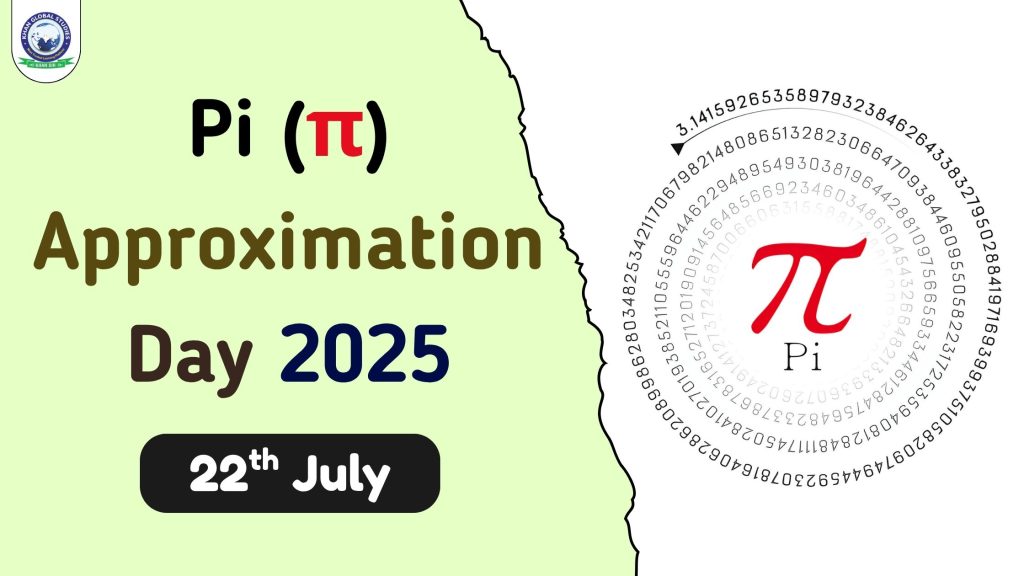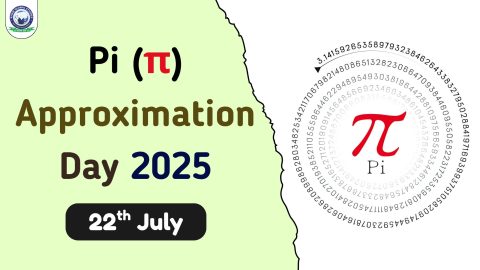Pi Approximation Day, observed on July 22, is a celebration of the mathematical constant π (Pi), one of the most fascinating and essential numbers in the field of mathematics and science. The date, 22/7, is significant because it represents the fractional approximation of Pi (π ≈ 22/7), widely used before the invention of modern computing tools.
This day holds great educational value, especially for mathematics enthusiasts, educators, and students around the globe. It encourages curiosity, learning, and appreciation for the infinite wonders of math.
What is Pi (π)?
Pi (π) is an irrational number, meaning it cannot be expressed exactly as a fraction of two integers. It represents the ratio of a circle’s circumference to its diameter, a constant that has intrigued mathematicians for centuries.
The value of Pi is approximately 3.14159, but since it is an infinite, non-repeating decimal, it continues endlessly without any pattern. In practical applications, it is often approximated as 22/7, hence the celebration on July 22.
Why Do We Celebrate Pi Approximation Day on July 22?
While March 14 (3/14) is globally recognized as Pi Day, July 22 offers a more precise approximation of the value of Pi in fractional form. The fraction 22/7 = 3.142857… is a commonly used approximation and is much closer to the actual value of Pi than just 3.14.
This day provides an opportunity to:
- Explore the history of mathematical discoveries
- Engage students in creative math-related activities
- Foster a culture of curiosity and logical reasoning
- Celebrate the endless nature of mathematics
Historical Background of Pi
The concept of Pi dates back more than 4,000 years, with traces in ancient Egyptian and Babylonian mathematics.
- The Babylonians approximated Pi to be about 3.125, while the Egyptians used a value close to 3.16049.
- Archimedes of Syracuse did the first rigorous calculation of Pi in the 3rd century BCE. He used the method of exhaustion to approximate Pi between 3.1408 and 3.14285, which aligns closely with the fraction 22/7.
Over the centuries, many mathematicians—including Liu Hui, Aryabhata, Madhava of Sangamagrama, and later Ramanujan—contributed to more accurate approximations of Pi.
Interesting Facts About Pi
- Pi is transcendental, meaning it is not the root of any non-zero polynomial equation with rational coefficients.
- The decimal representation of Pi has been computed to over 62.8 trillion digits (as of 2021) using supercomputers.
- Albert Einstein’s birthday falls on March 14, which coincidentally is Pi Day.
- The Greek letter π was first used to represent the constant in 1706 by Welsh mathematician William Jones and popularized by Leonhard Euler.
How to Celebrate Pi Approximation Day?
1. Organize Mathematics Quizzes and Competitions
Celebrate this special day in schools and colleges by hosting math-based quizzes or puzzle-solving competitions. Focus on:
- Pi-related trivia
- Circle geometry problems
- Mathematical riddles
2. Bake and Share Pies
A fun and pun-intended way to celebrate is by baking pies. After all, “Pi” sounds like “Pie”, making it a delicious and engaging way to connect food with mathematics.
3. Host Educational Workshops and Seminars
Organize workshops or online seminars to explore:
- The history and computation of Pi
- Applications of Pi in engineering, astronomy, and physics
- Recent advancements in Pi calculation
4. Recite the Digits of Pi
A popular activity among students and Pi enthusiasts is to memorize and recite as many digits of Pi as possible. The world record for memorising Pi digits stands at tens of thousands.
5. Watch Documentaries and Read Books on Mathematics
Some fascinating books and documentaries you can enjoy on Pi and mathematics:
- “The Joy of Pi” by David Blatner
- “A History of Pi” by Petr Beckmann
- Nova’s documentary “The Great Math Mystery”
Significance of Pi in Modern Science and Technology
Pi is more than just a classroom concept; it’s a critical constant in various real-world applications, including:
- Engineering: Designing mechanical systems, structures, and fluid dynamics.
- Astronomy: Calculating planetary orbits, stars’ positions, and trajectories.
- Physics: In wave theory, quantum mechanics, and signal processing.
- Computer Science: Used in simulations, algorithms, and even cryptography.
Pi in Ancient Indian Mathematics
India has a rich history of mathematical innovation, and the approximation of Pi is no exception:
- Aryabhata in the 5th century CE gave Pi as 3.1416, accurate to four decimal places.
- Madhava of Sangamagrama, a 14th-century mathematician from Kerala, derived infinite series for Pi, laying the foundation for calculus long before Newton and Leibniz.
Mathematical Curiosity: Beyond Pi
On Pi Approximation Day, it’s also a great time to explore other mathematical constants and their significance:
- e (Euler’s Number): The base of natural logarithms
- φ (Phi or Golden Ratio): Found in nature and art
- i (Imaginary Unit): The square root of -1, essential in complex numbers
Why Pi Continues to Fascinate the World?
The endless, patternless nature of Pi represents the mystery and beauty of mathematics. Despite our advanced tools, Pi remains a never-ending puzzle, challenging both humans and computers.
Its simplicity—just a ratio of a circle’s circumference to its diameter—and its complexity—an irrational, transcendental number—show why it is celebrated not just once, but twice a year.
Conclusion
Pi Approximation Day, celebrated on July 22, is more than a quirky holiday—it’s a tribute to the power of human curiosity and the timeless nature of mathematics. Whether you are a student, a teacher, or just someone who loves numbers, take a moment on this day to marvel at π, the circle, and the infinite wisdom that lies in math.





